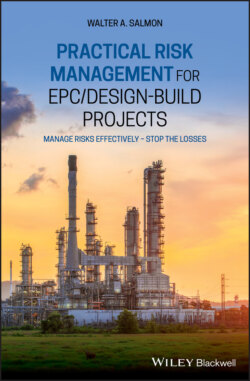Читать книгу Practical Risk Management for EPC / Design-Build Projects - Walter A. Salmon - Страница 43
3.9 Forging an Integrated Implementation Team
ОглавлениеAnother area of Project working that is all too often overlooked or not accorded enough attention is building an integrated implementation team that is working to the same objectives. I have observed that if the people on the tools can see that the Project Management Team members are concerned with the welfare and well-being of all staff when working in difficult overseas situations, then it can generate a good team spirit. I am not advocating that management personnel should jump into the trenches to help out with urgent cable pulling if the labour force is understaffed. However, I once saw that done to very good effect, and it demonstrated to a lot of the management staff (including me) the benefit of breaking down the traditional barriers that often still exist today between management staff and the manual workforce. I am referring more to the need to make the lives of the workers more tolerable in tough environments where they are far from their families and loved ones.
In such cases it costs very little extra to arrange a sports day where the emphasis is on fun, or a barbecue-on-the-beach day. Holding film nights with the latest movies on show also helps boost morale, as does ensuring that televisions are provided to everybody, with access to a good selection of movies, and even Internet entertainment (with a stable connection). Providing wholesome and tasty food too, as well as worthwhile gymnasium facilities for excess calories to be worked off, also helps people feel more comfortable when they are working away from home. The list of other possibilities for making the lives of the workers better is long, and it just needs a little imagination and effort to give effect to such ideas.
The opposite approach to the above is if the workers on the Site are simply being pushed to get the Project finished on time without necessary additional resources being provided, and with little done to provide relief for the workers in their free time. This very quickly leads to workers being demotivated, and both productivity levels and work quality can then suffer as a result. In addition, and far more importantly, more risks may be taken by the workers due to their weariness. This same pressure can of course be applied to the Engineering and Procurement Teams with their office work. However, the consequences are much more likely to be the need to redo work or place ‘top-up’ orders for additional materials (with consequent higher cost implications), as opposed to risking the safety and health of the workers involved. Nonetheless, the additional stress that may be caused by constantly working under high pressure should not be an insignificant matter of concern. I myself have seen a number of good people fall by the wayside due to pressure of work. The safety, health, welfare, and general well-being of the workers should therefore be of the highest importance to the Contractor, and it requires a lot of effort and dedication from the management team to be successful in keeping the workers contented.
Of course, worker safety must be seen by all to be a critical aspect of how the Contractor operates. However, The Contractor must be careful that this is not viewed as purely a numbers game but, instead, it must be clearly shown that the HSE efforts stem from a genuine desire to keep the workers safe at all times. Aligning the productivity desires of the Contractor's Project Management Team with the requirement to ensure the safety of the workers means that much more attention needs to be given as to how the individual on-Site activities are performed.
It is fine to aim for finding ways to get the job done quicker, but that must be achieved by not adding risks to worker safety. In addition, working quicker must not compromise the quality of the finished product. This requires the management team to discuss detailed work procedures with the workers themselves, in order to fully explore improvement possibilities. However, I have observed that such steps are rarely taken. Unless such integrated team working is instituted from the Corporate Management Team all the way down to artisan level, a Contractor's chances of achieving top-notch ‘Operational Excellence’ (OE) will never materialise. In regard to OE, I particularly found Price's definition of OE very appropriate: ‘building a sustainable competitive advantage through operations management’ since, as he says, that objective ‘accommodates process, culture, and results’.11 Since working properly towards achieving OE promises to be an almost sure-fire way to reduce risks (not least for the manual workforce), as well as increase profitability for the Contractor, I for one consider that OE is a goal worth striving for. I am therefore hoping that the concept catches on in a big way.
